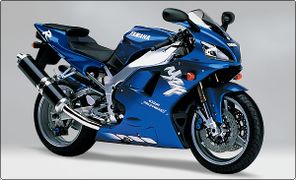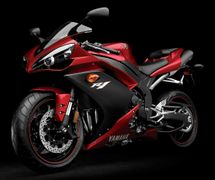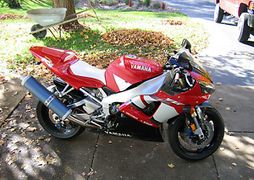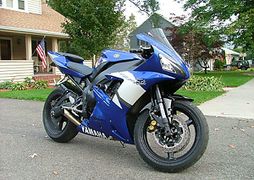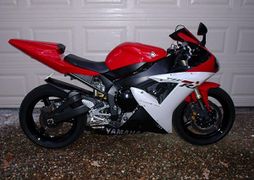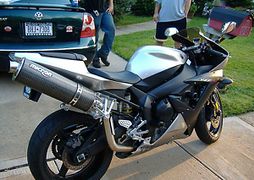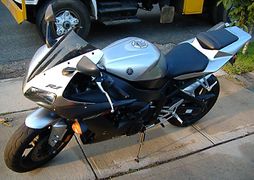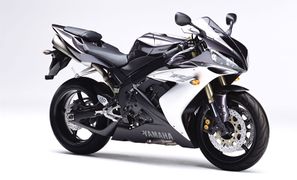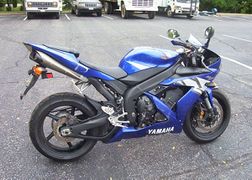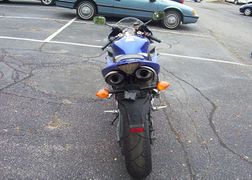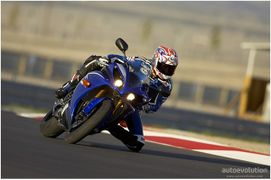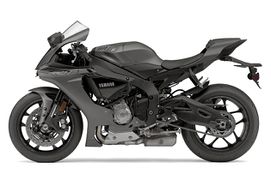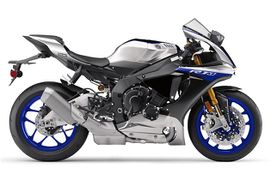Yamaha YZF-R1
 |
|
| Yamaha YZF-R1 | |
| Manufacturer | |
|---|---|
| Also called | YZF R1, YZF-R1 10h Anniversary, YZF-R1SP, YZF-R1 WGP50th Anniversary, YZF-R1 WGP 50th Anniversary, YZF-R1 60th Anniversary, YZF-R1S, YZF-R1 LE, YZF-R1M |
| Production | 1999 - 2019 |
| Class | Sport Bike |
| Predecessor | Yamaha YZF1000R |
| Engine | in-line four, four-stroke |
| Bore / Stroke | 79.0mm x 50.9mm |
| Compression ratio | 13.0:1 |
| Top Speed | 182 mph (293 km/h) |
| Horsepower | 195.79 HP (146.0 KW) @ 13500RPM |
| Torque | 82.91 ft/lbs (112.4 Nm) @ 11500RPM |
| Air Filter | K&N YA-1098 `98-01[1] |
| Ignition | tci: transistor controlled ignition |
| Spark Plug | NGK CR9E 99-03 NGK CR9EK '04-07 |
| Battery | YUASA YT12B-BS 99-03 YUASA YTZ12S '04-07 |
| Transmission | Gear box: 6-speed Final Drive: chain |
| Final Drive | Chain: 530 `99-03[2] |
| Suspension | Front: 43mm kyb® inverted fork; fully adjustable Rear: kyb® piggyback shock, 4-way adjustable |
| Brakes | Front: double disc. abs. hydraulic. four-piston calipers. Rear: single disc. abs. |
| Front Tire | 120/70-zr17 |
| Rear Tire | 190/55-zr17 |
| Wheelbase | 55.31 inches (1405 mm) |
| Length | 80.91 inches (2055 mm) |
| Width | 27.2 inches (691 mm) |
| Height | 45.31 inches (1151 mm) |
| Seat Height | 33.7 inches (856 mm) |
| Weight | 396.83 pounds (180.0 Kg) (dry), 200.0 kg (wet) |
| Oil Capacity | 1.03 Gallon (3.90 Liters) |
| Oil Filter | K&N KN-204[1] |
| Recommended Oil | Yamalube 10w-40 |
| Fuel Capacity | 4.5 Gallon (17.03 Liters) |
| Fuel Consumption | 6.92 liters/100 km (14.5 km/l or 33.99 mpg) |
| Related | Yamaha YZF-R6, Yamaha FZ1 |
| Competition | Honda CBR954RR Suzuki GSX-R1000 Ducati 1198 Kawasaki ZX-10R |
| Manuals | File:Yamaha YZF-R1 1998 Service Manual.pdf 1999 Yamaha YZF-R1 K Owners Manual More Manuals |
The Yamaha YZF-R1 was a in-line four, four-stroke Sport Bike motorcycle produced by Yamaha between 1999 and 2019. It could reach a top speed of 168 mph (270 km/h). Max torque was 82.91 ft/lbs (112.4 Nm) @ 11500 RPM. Claimed horsepower was 195.79 HP (146.0 KW) @ 13500 RPM.
Overview[edit | edit source]
The Yamaha YZF-R1 motorcycle, first built in 1998, helped initiate the litre class "handling arms race" between the Japanese Big Four motorcycle manufacturers (Honda, Kawasaki, Suzuki and Yamaha). When it was first introduced it was considered a groundbreaking design; a 1000 cc engine in a frame the size of a 600 cc bike. It was on par with the power output ratings of its competition but it was unique with its unprecedented agility. The key in the R1's success was the redesigned Genesis engine. In traditional inline-4 motorcycle engines the crankshaft, gearbox input and output shafts were parallel in a flat plane; in the R1 the shafts formed a triangle. This made the engine very short, allowing the Wheelbase to be shortened greatly, which in turn led to the exceptional handling. This bike has a compression ratio of 12.4:1.The Yamaha R1 has a transmission of 6-speed w/multi-plate clutch.
The R1 was dominant for five years before the competition could catch up to its level. In 2003 the Suzuki GSX-R 1000 and in 2004 the Kawasaki ZX-10R have successfully challenged the R1. The 2004 R1 produces 180 hp at the crankshaft and also weighs the same in kilograms, giving it a theoretical 1:1 power-to-weight ratio, however the horsepower that is released at the rear wheel is closer to 150hp (or more, under properly tuned and optimal conditions). The R1 is able to do 107 mph in first gear. In 2006 the Yamaha R1 expanded its output to 175 hp in addition to a 20 mm longer swingarm. The 2006 model year for the R1 is groundbreaking with the release of the Limited Edition model. At the MSRP of $18,000 and only 500 units made for the United States makes ownership very limited, marking the 50th Anniversay year for Yamaha.
Engine[edit | edit source]
The engine was a liquid cooled in-line four, four-stroke. A 79.0mm bore x 50.9mm stroke result in a displacement of just 998.0 cubic centimeters. Fuel was supplied via a double overhead cams/twin cam (dohc).
Drive[edit | edit source]
The bike has a 6-speed transmission. Power was moderated via the multiplate assist and slipper clutch.
Chassis[edit | edit source]
It came with a 120/70-zr17 front tire and a 190/55-zr17 rear tire. Stopping was achieved via double disc. abs. hydraulic. four-piston calipers. in the front and a single disc. abs. in the rear. The front suspension was a 43mm kyb® inverted fork; fully adjustable while the rear was equipped with a kyb® piggyback shock, 4-way adjustable. The YZF-R1 was fitted with a 4.5 Gallon (17.03 Liters) fuel tank. The bike weighed just 396.83 pounds (180.0 Kg). The wheelbase was 55.31 inches (1405 mm) long.
1998[edit | edit source]
1999 Yamaha YZF-R1[edit | edit source]
The Yamaha YZF-R1 was top dog sports bike until the GSX-R1000 appeared in 2001. Parallel imports and stiff competition from Honda and Suzuki mean prices stay sensible. But equally there’s no such thing as a good.
2000 Yamaha YZF-R1[edit | edit source]
Yamaha's most popular superbike, the R1 carries on the company's heritage and continues to mesmerize the thrill-seekers. With an unmistakable sound signature, this 4 in-line machine has a rumble which reminds of the V engines, thanks to its firing interval.
With 150 horsepower on tap, this 175 kg beast is a blast to ride both on the track or along the open highway. With comprehensive dashboard instruments, the R1 is ready to take on the stopwatch attack as well as on the canyon curves.
2001[edit | edit source]
2002[edit | edit source]
2003 Yamaha YZF-R1[edit | edit source]
The 2003 YZF-R1 is Yamaha's world-famous superbike, a machine which received the Sport Rider Magazine's Bike of the Year on two occasions. Yamaha refined the 20-valve 4 in-line engine and added even more precise control over the performance of the power unit, thus providing sport riders with even more fun both on the street and on the race track.
The bikes use the third generation of the Deltabox frame, taking things further into the realm of high-performance machinery.
2004 Yamaha YZF-R1[edit | edit source]
This model year brings the 4th generation of R1 machines, using the 3rd iteration of the 998cc short-stroke, 20-valve engine loaded in the Deltabox V frame. The bike comes with factory-installed titanium EXUP exhausts which give a 56-degree cornering clearance for die-hard racers.
The R1 also gets new wheels this year, with radial-mount calipers and massive 320mm discs which offer excellent control both on the track and on the street. With new, sizzling hot liveries, the 2002 Yamaha R1 is here to make a bold statement.
2005 Yamaha YZF-R1[edit | edit source]
The 2004 R1 carries on the successful recipe, with the proven 998cc, 180hp, ram-air injected recipe, a more carefully-distributed weight and a revised power management software. The result is a spectacularly nimble superbike, with a high-compression engine and equally high performance thanks to the lightweight Deltabox aluminum chassis and top-notch WSBK-inspired suspensions, steering damper and premium brakes.
A track-worthy package in a streetable guise, the 2004 YZF-R1 is a reputable adversary both on the closed track and on curvy canyon asphalt.
2006 Yamaha YZF-R1[edit | edit source]
The R1 got various revisions for the 2006 model year and Yamaha was able to squeeze even more power from the 998cc in-line 4 engine. No less than 3 extra horsepower have been added, thanks to the new cylinder head, while the modified frame with a longer swingarm offers better traction and stability, while handling also go better.
One of the really popular superbikes in the market, the R1 carries on the sporting heritage and the new MY offers the same high-performance riding nerve so many motorcyclists around the world loved about this bike. On the roads and track alike, the 2005 R1 is one sparkling jewel.
2007 Yamaha YZF-R1[edit | edit source]
Yamaha Chip Controlled Intake (YCC-I), the first ever electronic variable intake system on a production motorcycle, is introduced on the YZF-R1 to achieve the broadest possible powerband.
The engine in the 2007 R1 is more powerful than the previous versions, but managing all the power is however an easier task, at least for slightly more experienced riders. The Deltabox V frame design provides better control and enhanced rigidity, while helping centralize mass better for an even more nimble feel. Electronics for this engine have also been updated.
Almost the entire bike has received upgrades and revisions, so the 2007 R1 is capable of delivering higher performance, and get even closer to the race track where it was conceived. Add in a new bodywork with more aggressive lines and better aerodynamics, with a screwless wind shield for a sleeker attire.
2008 Yamaha YZF-R1[edit | edit source]
The 2008 MY YZF-R1 spells zero-compromise bike-making excellence, one thing Yamaha is particularly good at. The already breathtaking engine was furthermore revised with a lot of titanium and other lightweight alloys for weight saving, and an all-new slipper clutch added a more precise torque deployment to the rear wheel.
The frame also received updates, and became lighter and more rigid, providing a max leaning angle of 56 degrees. GP-derived brakes are standard, just like the aerodynamic faring inspired from the racing program.
2009 Yamaha YZF-R1[edit | edit source]
The 2009 MY YZF-R1 retains the acclaimed crossplane crankshaft for exceptionally smooth, linear throttle for an incredible feeling of being actually connected to the bike and rear tire. The all-new engine for 2009 feels and sounds smoother, and its MotoGP-derived inspiration makes it the most advanced power plant ever to sit in a Yamaha sport machine.
Yamaha has also made major changes for the Deltabox aluminum frame, has brought solid updates to the bodywork and refined the SOQI independent damping fork's performance for even better cornering.
2010 Yamaha YZF-R1[edit | edit source]
The YZF-R1 is a super-sport motorcycle manufactured by Yamaha Motor Company since 1998. The 2009 Yamaha YZF-R1 receives MotoGP technology from the M1, to be more precise the new R1 will use a cross-plane crankshaft, and it's the first street legal motorcycle to use this kind of technology. Cross-plane technology, puts each connecting rod 90° from the next, with an uneven firing interval of 270°- 180°- 90°- 180°. The idea of this technology is to reduce inertial crankshaft torque, therefore giving the new R1 a more linear power delivery.
2011 Yamaha YZF-R1[edit | edit source]
The 2011 MY YZF-R1 carries on the MotoGP-inspired crossplane crankshaft technology for an engine that is surprisingly nimble and which also sounds great. An in-line 4 architecture that sounds almost like a V is definitely a cool thing, adding to the overall sizzling hot features of the R1. A sporty machine that feels at home on the track, the R1 also has a seating position which makes it suitable for daily commuting.
Race-inspired suspensions and brakes complement the evil engine, increasing maneuverability and adding to the pleasure of riding it. Chip-controlled ignition and throttle are standard.
2012 Yamaha YZF-R1[edit | edit source]
The 2012 MY R1 receives a new, more aggressive front fairing which improves air management, and a 7-way traction control system aimed at putting the rider in total control of the bike even under very hard acceleration on less-than-ideal surfaces. Also on the "new" list, we must add the LED lighting, MotoGP-inspired silencer end caps, the new heat shields, revised ECU settings for better low and mid range power deployment, new triple clamps, redesigned footrests with a bigger contact patch with the rider's boot sole. Add in iridium plugs, a slipper clutch and Ram Air induction for an even more sizzling high-performance experience.
2016 Yamaha YZF-R1M[edit | edit source]
The 2015 R1M features a completely new, lightweight and compact, crossplane-concept,inline-four-cylinder, 998cc engine that delivers high horsepower and a strong pulse of linear torque for outstanding performance. The R1M has Twin injectors fueling each cylinder. A bi-directional spray in the lower injectors directs fuel towards the back of the intake valves to maximize th enumber of droplets that go directly into the combustion chamber.
2016 Yamaha YZF-R1S[edit | edit source]
The Yamaha has introduced the new RS1 for 2016, a less-expensive alternative to the standard R1, but with the same superb electronics package and nearly the same performance. Yamaha is quick to point out that the new R1S is not a detuned R1. But there are differences between the bikes. Most obvious visually are the five-spoke aluminum wheels that have replaced the superlight multispoke magnesium units on the standard R1. And with regard to the R1S engine, it’s the familiar 998cc inline-four with the crossplane crank, but the R1’s trick fracture-split titanium connecting rods have been replaced by conventional ones made of steel. The DOHC cylinder head is the same, but new valve springs are now used, likely related to an unspecified lower redline. What’s more, the oil pan and right-side engine cover, magnesium on the standard R1, are now aluminum, and stainless steel exhaust headers have replaced the ones made of titanium.
2016 Yamaha YZF-R1[edit | edit source]
Packed with MotoGP YZR-M1 technology, a crossplane engine, short wheelbase chassis and high-tech electronics, the R1 is ready to connect to your body and take your riding to a new level. Developed without compromise using YZR-M1 MotoGP technology, the R1 was born for the track. 200PS, 199kg and 1,405mm wheelbase give an insight into its capabilities. But it's what you can't see that makes this focused superbike so special
2017 Yamaha YZF-R1M[edit | edit source]
The 2017 YZFR1M comes equipped with a 998 cc in-line 4-cylinder, crossplane crankshaft engine features titanium fracture-split connecting rods, which are an industry first for a production motorcycle. The specific titanium alloy used to manufacture the new connecting rods is around 60% lighter than steel, and this major reduction in weight gives the R1M engine a responsive and potent character at high rpm.
In Media[edit | edit source]
- Vozmezdie
- C-BooL: Pit Stop
- Cymbeline
- Vuelveme a querer
- La que se avecina
- Odmori se, zasluzio si
- Circumstance
- ¿Y ahora qué hago?
- Inocente de ti
- W kogo ja sie wrodzilem?
- William & Catherine: A Royal Romance
- Last Run
- Torque
- Sseom
- Dalziel and Pascoe
- Daddy Yankee: Gasolina
- Il cartaio
- Die Motorrad-Cops: Hart am Limit
- Going Off Big Time
- 15 Storeys High
- Leprechaun: Back 2 Tha Hood
- Chas Volkova
- The Fast and the Furious
- Biker Boyz
- Jeremy Clarkson: Head To Head
- Debora: Tvoya
- Mañana es para siempre
- NCIS: Los Angeles
- Smotryashiy vniz
- Andrey Gubin: Bud' so mnoy
- Hackney's Finest
- The Player
- Commissaire Magellan
- Alex Hugo
- Flo Rida Feat. Sage the Gemini and Lookas: G.D.F.R.
- Obnimaya nebo
- Prisionera
- La marca del deseo
- The Counsellor
- Killer Women
- Policajti z centra
- Ojciec Mateusz
- 360
- The Unit
- Weezer: Dope Nose
- Autofil
- Ciara feat. T-Pain: Go Girl
- Madventures
- Ti stramo
- Boy s tenyu
- Never Back Down
- Stritreysery
- Alicia Keys: Like You'll Never See Me Again
- Juyuso seubgyuksageun
- Commissaire Moulin
- The Black Eyed Peas: My Humps
- Hassel
See Also[edit | edit source]
References[edit | edit source]
- ↑ 1.0 1.1 2019 K&L Supply Co Catalog. K&L Supply Co. 2019.
- ↑ 2019 Western Power Sports Catalog. Western Power Sports. 2019.
| ||||||||

